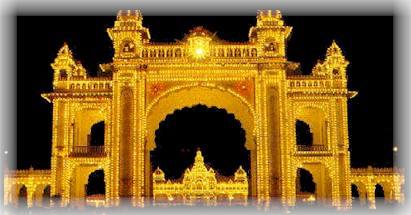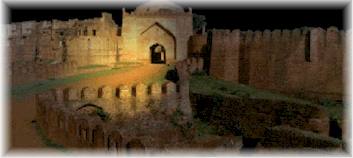India > Forts & Monuments > Karnataka
KARNATAKA
Mysore Palace

Also known as the Amba Vilas Palace, the beautiful profile of this walled Indo-Saracenic palace, the seat of the maharajas of Mysore, graces the city's skyline. An earlier palace burnt down in 1897 and the present one was completed in 1912.
Inside it's a klaeidscope of stained glass, mirrors, there are also beautiful carved wooden doors and mosaic floors, as well as a whole series of mediocre, though historically interesting, paintings depicting life in Mysore during the Edwardian Raj. Note the beautifully carved mahogany ceilings, solid silver doors, white marble floors and superb columned Durbar hall. The palace even has a selection of Hindu temples within the palace walls including the Varashaswamy temple with a gopuram which set the pattern for the later Sri Chamundeswari temple on Chamundi hill. The former maharaja is still in residence at the back of the palace.
Places to Stay
Lalitha Mahal Palace Hotel, Quality Inn Southern Star, Hotel Metropole, Kings Kourt Hotel.
Getting There
There are five daily express services to and fro Bangalore. The Central bus terminal handles all the KSTRC long distance buses.
Bidar Fort

Located in the north-east corner of Karnataka, Bidar was once the capital of he Bahamani dynasty and the Badri Shahi kingdom. Perched on a rocky escarpment, this isolated, yet pleasant town deserves a visit with its crumbling red ramparts harbour and Persian style architecture.
History
In 1424 Ahmed Shah I shifted his court from Gulbarga to a less constricted site at Badri, in grief of his beloved spiritual mentor, Bandah Nawas Gesu Daraz. Later the Bahamani dynasty continued to rule here till 1487 even after they were split into five rival groups. They refurbished the town by building a new fort, splendid palaces, mosques and ornamental gardens. They were then succeeded by the Adil Shahis from Bijapur, followed by the Mughals under Aurangzeb, who annexed the territory in 1656, before the Nizam of Hyderabad acquired the territory in the early 18th century. The town has a gritty charm, with narrow red-mud streets leading to arched gates and open vistas across plains. Bidar is nowadays a provincial backwater, better known for its fighter pilot training base.
Bidar fort Built in the 15th century by the Chalukyas and later strengthened by the Bahamanis, this fort is one of the main attractions in Bidar. It is encircled by ramparts and protected by massive gates at its entrances. The views it offers over the steep cliffs are incredible.
The Old Town
The heart of Bidar is its medieval old town, encircled by crenelated ramparts and eight imposing gateways (darwazas). This predominantly Muslim quarter holds many Bahamani era mosques, bungalows (havelis) and monastries (khanqahs), set up by the local rulers for Muslim cleric mystics and their disciples.
Mahmud Gawan's Madrasa
This theological college, whose single minaret soars high above the city centre, is the highlight of the old town. Gawan, a scholar and Persian exile, was the Prime Minister of the Bahamani state under Muhamad Bahamani III. Being a talented linguist, mathematician and inspired military strategist, he oversaw the dynasty's expansion into Goa and Karnataka, bequeathing this college as a thank you gift to his adoptive kingdom in 1472. Originally surmounted by large bulbous domes, this distinctively Persian style building once housed a world famous library. However in 1696 the building was burnt down after being struck by lightning, while several of the walls were blown away when gunpowder stored here by Aurangzeb's occupying army, caught fire and exploded. Yet inspite of these incidents, the elegant arched façade of the madrasa has still retained large patches of the vibrant Persian glazed tile work that once covered most of the exterior surfaces. This includes a beautiful band of Koranic calligraphy, and striking multi-coloured zigzags wrapped around the base of the once remaining minaret.
The Badri Shahi Tombs
The tombs of the Badri Shahi rulers, who succeeded the Bahamani dynasty, in the early 16th century, lie on the western side of the town. The mausoleums, mounted on raised plinths occupy an attractive site. The tombs are randomly spaced and are surrounded by lush-green lawns. The most interesting is the tomb of Ali Barid, whose Mecca-facing wall was left open to the elements. A short distance south-west lies a mass grave platform for his 67 concubines, who were sent as a tribute by vassals of the Deccani overlord from all across the kingdom.
Ashtur: The Bahamani Tombs
3km from Bidar, Ashtur is where the mausoleums of the Bahamani rulers and their families lie. The most impressive tombs are those, which belong to Allaudin Shah I, and his father from Gulbarga. The exterior of the tomb has glazed Persian tiles on its arched facade and the interior surfaces of the dome are writhe with sumptuous Persian paintings.
Chaukhandi (tomb) of Hazrat Khalil Ullah
On the north side of the road between Ashtur and Bidar lies this beautiful octagonal-shaped tomb, which was built by Allaudin Shah for his chief spiritual advisor. Most of the Persian glazed tiles have dropped off the facade, but the surviving stone work and calligraphy above the arched doorway along with the views from the tomb’s plinth deserve a quick detour form the way.
Interesting Artifacts
Bidar is renowned as the home of a unique damascene metalwork technique known as Bidri, developed by the Persian silversmiths that came to the area with the Bahamani court in the early 15th century. Since then this has become the hallmark of Muslim metalwork in India. These highly skilled artisans engraved and inlaid their traditional Iranian designs onto a metal alloy composed of lead, copper, zinc and tin, which they blackened and polished. This resulted in swirling silver floral motifs, framed by geometric patterns and set against black backgrounds. Some of the objects they engrave are vases, goblets, plates, spice boxes as well as less traditional objects like coasters, ashtrays and ornaments. Bidri objects of art are displayed in museums and galleries all over the country. One can see the typical Bidri workers engrossed in their work of art at Bidar's Siddiq Talim road.
Getting There
By Rail: Bidar lies on the main Mumbai-Secunderabad-Madras rail route and can only be reached by a slow passenger train.
By Road: The Karnataka state transport has bus services from Hyderabad, Gulbarga and Bijapur.
Places to Stay
Hotel Bidar International is a good hotel option in Bidar. The Maurya Barid Shahi and Udupi Krishna restaurants serve good and delicious food.
Somnathpur
"There is a stillness and everlastingness about the past, it changes not and has a touch of eternity," wrote Pt. Jawaharlal Nehru in his "Discovery of India". These words somehow seemed to echo our own feelings when we arrived at Somnathpur, a tiny village on the banks of the Kaveri, 140 km south-west of Bangalore. Here in this everlasting rural stillness, like a milestone to eternity, stood one of the last and the grandest of Hoysala monuments - the Kesava temple built 740 years ago.
In the dust and turmoil of history, India was witnessing the Golden age of the mighty Cholas, Pandyas and the Hoysalas. The last named dynasty which ruled Karnataka for nearly 350 years, was founded in 1006 AD, soon after the collapse of the Ganga dynasty.
By the year 1268 AD - the year in which the Kesava temple at Somnathpur was built - the Hoysala rule had completed 260 years. The riches and splendour of the Hoysala court were already evident in their grand temples at Belur and Dvarasamudra (present day, Halebid). Incidentally, Belur was the first Hoysala capital founded by Vinayaditya (1045-98); later shifted to Halebid by Vinayaditya's son, Ereyanga. Halebid then was fortified city with 12 gates.
Coming to the temple at Somnathpur, one need not search far for its history. An inscribed stone slab, in old Kannada, at the entrance says it all. The reigning monarch was Narasimha III (1254-91 AD) whose full regal title runs into a sizeable paragraph: "Sri Vishnuvaradhana, Pratapa Chakravarti, Hoysala Bhujabala, Sri Vira Narasimha, Maharajadhiraja, Raja Paramesvara, Sanivarasiddhi, Giridurgamalla…..etc".
The temple, however, was not built by the king but by his celebrated army commander, Somnath. Some year ago he had founded a village on the left bank of the Kaveri river, which he named Somnathpur, after himself. Now in a bid for further immortality, Somnath petitioned the king to grand him the permission and resources for his project of setting up a grand temple to glorify Hoysala craftsmanship.
The king not only bestowed Somnath with his largesse, but also sanctioned an annual grant of 3,000 gold coins for the temple's upkeep and maintenance. All these facts are duly mentioned on the slab and appear as though to have happened yesterday!.
Soon work began. The best sculptors in the realm were commissioned for the task. There came sculptors whose wizardry with the hammer and chisel was almost legendary. Among them was the famous Mallitamma. Then there were sculptors : Ballayya, Chaudayya, Bharmayya, Kamayya and the Nanjayya. Of the 194 carved images on the outer walls, Mallitamma's contribution was forty. We know this because all the sculptors have signed their works - a practice unusual for its times, but also evident in Hoysala temples at Belur and Halebid.
For the inscription on the stone slab, it becomes fairly evident that the magnificent temple was completed and consecrated in 1268 AD. The shrine stands in the middle of a walled compound, around which runs an open verandah with 64 cells. The temple itself, stellar in shape, has three profusely carved pinnacles with a common Navranga and stands on a raised platform. The three sanctums once housed beautifully carved idols of Kesava, Janardhana and Venugopala. Today the idol of Lord Kesava is missing, but the other two still adorn the sanctums in their original form.
Interestingly, the earliest Hoysala monarchs were Jains. It was the great Vishnuvardhana (1108-42) who embraced Vaishnavism under the influence of the celebrated Vaishnava reformer Ramanuja. Later Hoysala rulers even became Saivites. But general tolerance of all faiths was typical of their rule. The Hoysala Dynasty finally came to an end around 1346 AD when the Vijayanagar empire rose to power.
Today Somnathpur is like any other Lackadaisical Indian village surrounded by farms of millet and sugarcane. Not as famous as Belur and Halebid, the Hoysala temple at Somnathpur, however, is truly unique in design, perfect in symmetry and the stone carvings are remarkable marvels in stone.

